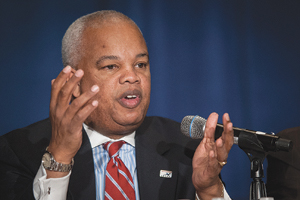FMCSA Finalizing New Rules to Target Unfit Drivers, Fleets

This story appears in the Jan. 19 print edition of Transport Topics.
WASHINGTON — The top U.S. trucking regulator pledged to step up its safety initiatives and outreach programs this year to aggressively go after commercial drivers unfit to operate on the nation’s highways.
In the battle to root out unqualified and unsafe drivers, Federal Motor Carrier Safety Administration acting Administrator Scott Darling said the agency also is in the final stages of drafting new rules for adopting safety fitness guidelines designed to help determine whether a carrier is suited to operate commercial motor vehicles.
He made the comments here last week during the Transportation Research Board’s annual conference.
Also, scrutiny of the controversial hours-of-service restart rule is due to begin this month with the selection of a research firm to conduct a congressionally mandated study.
The fitness-determination rule would replace the SafeStat system — which rates carriers based solely on compliance audits — with Compliance, Safety, Accountability data.
“I believe we would be more efficient and effective by leveraging data-collection analysis to assess carriers without necessarily being on-site. So we get to the worst of the worst, and then we use our resources to get to those other folks that are out there,” Darling said on Jan. 12.
Although American Trucking Associations has supported the CSA program, it has voiced concerns over using the program’s safety measurement system (SMS) data to rate carriers.
“ATA believes it is inappropriate for FMCSA to pursue a safety fitness determination rulemaking until such time as peer-reviewed research can confirm that SMS scores are an accurate and reliable predictor of individual motor carriers’ performance,” said Sean Garney, ATA’s director of safety policy.
At the conference, FMCSA also announced the availability of $30 million for states looking to modernize their safety data technologies. The Commercial Vehicle Information Systems and Networks and the Performance Registration Information Systems Management grant programs are designed to help state agencies improve the way they collect and disseminate real-time data to roadside inspectors and law enforcement officials. State agencies have until Feb. 2 to apply for the grants. The recipients will be announced in the spring, FMCSA said.
“We’re working every day to improve our risk-based assessment tools and data collection. We are also providing training opportunities for our field personnel and law enforcement partners,” Darling said. “I think the training, providing money to upgrade their systems and making sure that they put out good information in a timely fashion, helps us get good data and helps us ensure that we can use a risk-based approach to making decisions.”
Also, Transportation Secretary Anthony Foxx said, in the coming weeks, DOT will release a “framework” for the nation’s transportation system that looks at the next 30 years. “Beyond Traffic” as it is called, will lay out trends in everything from population shifts and growth to infrastructure decline and technology.
“We’re writing about these trends and framing the choices that future policymakers and stakeholders of all types at every level are ultimately likely to face,” Foxx said.
The secretary also said overall efficiency needs to be addressed: “How can we move projects faster on to completion without taking away the integrity of the project itself?”
Additionally, FMCSA announced it is poised to name a research firm this month to conduct a yearlong review of a new hours-of-service rule, parts of which were suspended through the end of September, said Martin Walker, head of FMCSA’s research division. The firm awarded the contract would be assigned to compare fatigue and performance levels of drivers who take a two-night rest period during a 34-hour restart with those who take less than a two-night period.
For the study, the agency is seeking drivers who record about 60 to 70 hours a week and work primarily at night. The drivers would need to come from various sectors of the industry at small and large fleets. By law, the firm has a year to complete the study, Walker said.
“FMCSA is working very diligently, and we are . . . working very hard to ensure that this study is contracted and awarded later this month,” Walker said Jan. 13. “We’re going to compare five months of driver work schedule” to review safety data. Information about how to participate in the study is on FMCSA’s website.
On Dec. 16, President Obama signed a $1 trillion fiscal 2015 funding bill into law that suspended through Sept. 30 FMCSA’s requirement that drivers take off two consecutive periods of 1 a.m. to 5 a.m. during a 34-hour restart. A bipartisan group of congressional leaders pushed to have the suspension of the new restart rule included in the funding bill signed into law.
The suspension was backed by the trucking industry, led by American Trucking Associations, which argued the new hours-of-service rules had not been sufficiently studied. Proponents of the rule countered that suspending them would add tired commercial drivers on main highways. Truckers still are required to account for a 30-minute break during their shifts and follow pre-July 2013 hours-of-service regulations.
Michele Fuetsch contributed to this report.

